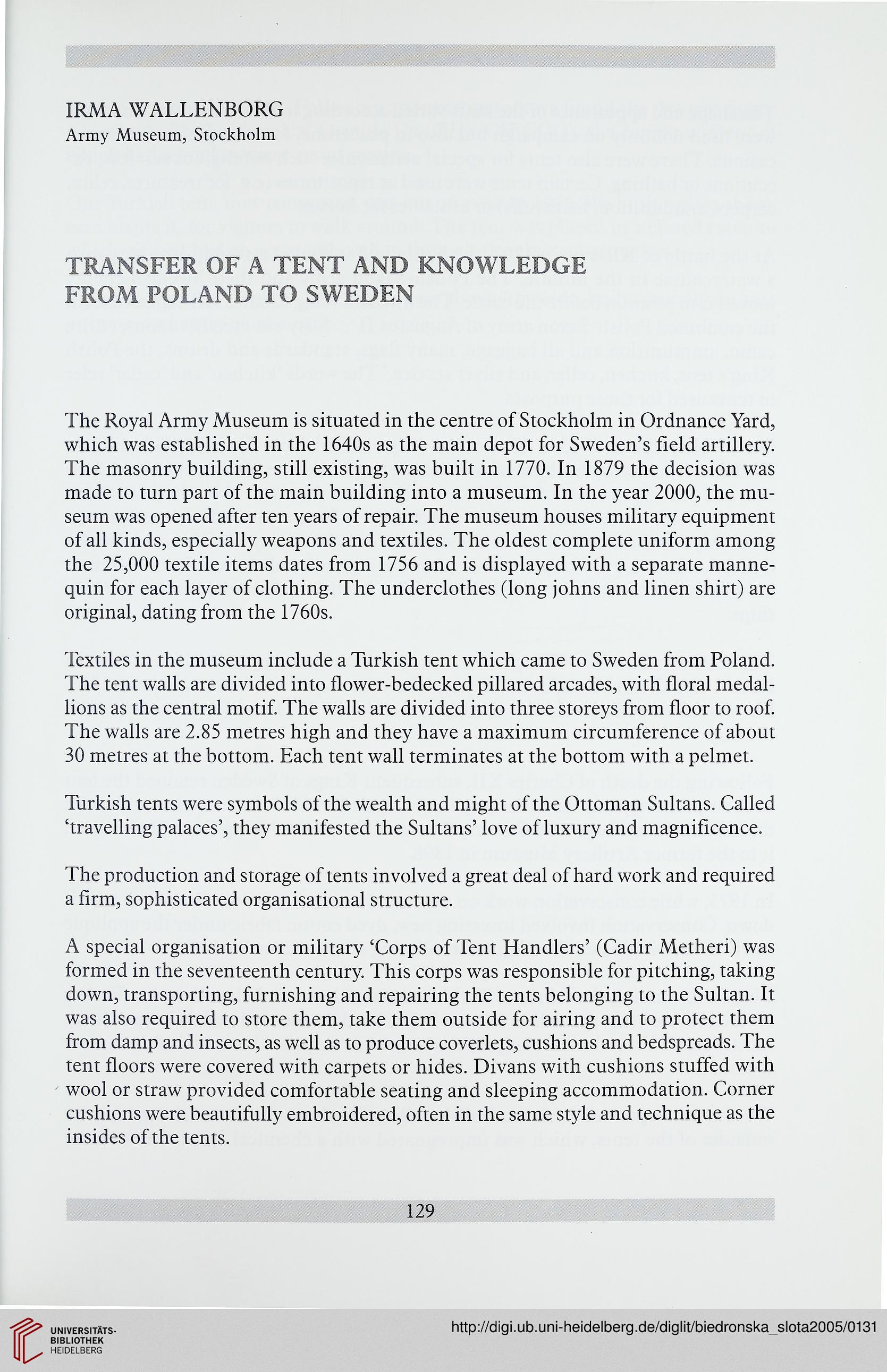IRMA WALLENBORG
Army Museum, Stockholm
TRANSFER OF A TENT AND KNOWLEDGE
FROM POLAND TO SWEDEN
The Royal Army Museum is situated in the centrę of Stockholm in Ordnance Yard,
which was established in the 1640s as the main depot for Sweden's field artillery.
The masonry building, still existing, was built in 1770. In 1879 the decision was
made to turn part of the main building into a museum. In the year 2000, the mu-
seum was opened after ten years of repair. The museum houses military eąuipment
of all kinds, especially weapons and textiles. The oldest complete uniform among
the 25,000 textile items dates from 1756 and is displayed with a separate manne-
quin for each layer of clothing. The underclothes (long johns and linen shirt) are
original, dating from the 1760s.
Textiles in the museum include a Turkish tent which came to Sweden from Poland.
The tent walls are divided into flower-bedecked pillared arcades, with floral medal-
lions as the central motif. The walls are divided into three storeys from floor to roof.
The walls are 2.85 metres high and they have a maximum circumference of about
30 metres at the bottom. Each tent wali terminates at the bottom with a pelmet.
Turkish tents were symbols of the wealth and might of the Ottoman Sultans. Called
'travelling palaces', they manifested the Sultans' love of luxury and magnificence.
The production and storage of tents involved a great deal of hard work and reąuired
a firm, sophisticated organisational structure.
A special organisation or military 'Corps of Tent Handlers' (Cadir Metheri) was
formed in the seventeenth century. This corps was responsible for pitching, taking
down, transporting, furnishing and repairing the tents belonging to the Sułtan. It
was also reąuired to storę them, take them outside for airing and to protect them
from damp and insects, as well as to produce coverlets, cushions and bedspreads. The
tent floors were covered with carpets or hides. Divans with cushions stuffed with
wool or straw provided comfortable seating and sleeping accommodation. Corner
cushions were beautifully embroidered, often in the same style and techniąue as the
insides of the tents.
129
Army Museum, Stockholm
TRANSFER OF A TENT AND KNOWLEDGE
FROM POLAND TO SWEDEN
The Royal Army Museum is situated in the centrę of Stockholm in Ordnance Yard,
which was established in the 1640s as the main depot for Sweden's field artillery.
The masonry building, still existing, was built in 1770. In 1879 the decision was
made to turn part of the main building into a museum. In the year 2000, the mu-
seum was opened after ten years of repair. The museum houses military eąuipment
of all kinds, especially weapons and textiles. The oldest complete uniform among
the 25,000 textile items dates from 1756 and is displayed with a separate manne-
quin for each layer of clothing. The underclothes (long johns and linen shirt) are
original, dating from the 1760s.
Textiles in the museum include a Turkish tent which came to Sweden from Poland.
The tent walls are divided into flower-bedecked pillared arcades, with floral medal-
lions as the central motif. The walls are divided into three storeys from floor to roof.
The walls are 2.85 metres high and they have a maximum circumference of about
30 metres at the bottom. Each tent wali terminates at the bottom with a pelmet.
Turkish tents were symbols of the wealth and might of the Ottoman Sultans. Called
'travelling palaces', they manifested the Sultans' love of luxury and magnificence.
The production and storage of tents involved a great deal of hard work and reąuired
a firm, sophisticated organisational structure.
A special organisation or military 'Corps of Tent Handlers' (Cadir Metheri) was
formed in the seventeenth century. This corps was responsible for pitching, taking
down, transporting, furnishing and repairing the tents belonging to the Sułtan. It
was also reąuired to storę them, take them outside for airing and to protect them
from damp and insects, as well as to produce coverlets, cushions and bedspreads. The
tent floors were covered with carpets or hides. Divans with cushions stuffed with
wool or straw provided comfortable seating and sleeping accommodation. Corner
cushions were beautifully embroidered, often in the same style and techniąue as the
insides of the tents.
129





